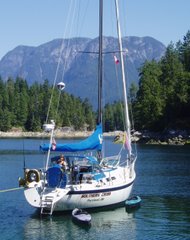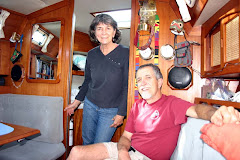We just returned from an 8-day dive trip to Socorro, and are still on a high from the experience! We booked passage on Nautilus Explorer rather than take our own boat.


It was a lot of money to go this route, but we definitely count it as one of our all-time most wonderful experiences. I get very emotional just thinking about the close and prolonged encounters that we had with the mantas, dolphins, sharks, and other sea life. We do not have a decent underwater camera so I can't post any underwater pics, but we do have a nice DVD compilation of all the other divers' photos, and I have one nice manta "fly-by" video that another diver generously shared with me. Unfortunately Blogger doesn't seem to want me to upload it.
We spent the first day diving at the Canyon on the S end of San Benedicto. This is a view of the cinder cone on San Benedicto.

The next day we checked in with the Mexican navy at the south end of Socorro Island. Visits are controlled by permit, and the Mexican navy helps keep poachers from decimating the rich and abundant sea life here.

After our check in, we went on to dive at Cabo Pierce on the E side of Socorro. The next day we dove at Pta Tosca on the W side of Socorro, and then spent 2 days at Roca Partida, which was the highlight of our trip. This rock is 75 miles from the nearest other island, and drops off to 250' on all sides. Here we saw a great variety of sharks and other pelagics, including schools of wahoo and yellowfin tuna.

Our last day was back at San Benedicto at the Boiler, where we had another really good encounter with dolphins, and saw mantas on every dive. After our 3rd dive of the day, we took the zodiacs in for a closer look at San Benedicto's rugged western coastline.


Diving conditions were challenging, as we had expected: strong surge, irregular and sometimes very strong currents. Unfortunately the viz was less than we had hoped for, typically only 30 feet at San Benedicto and Socorro, and 50-75 feet at Roca Partida. Water temp varied from 74-78F.

Fortunately we had an excellent crew on board. Of the 3 divemasters, I was most impressed with Sten, a Swedish Viking who knew these islands well and showed us many interesting things underwater.

Despite the somewhat challenging conditions, this area stands out as the best diving I have ever had, due to the wildlife and their behavior. The divemasters told us they know of nowhere else in the world where the mantas are so curious about divers. Many times a group of mantas would spend the entire dive around us, whether there were 2 people in the water or 20, and would closely approach each diver. Being eyeball to eyeball with these magnificent animals is as close as I have come to a spiritual experience.
Our encounters with dolphins at Roca Partida were also memorable. Like the mantas, they seemed more curious about divers than at any other location where I have encountered them previously. One of the divemasters told us of holding a dolphin in his arms and rubbing its belly on a previous trip; our encounters were not quite that close!
We saw quite a few shark species on this trip: great hammerheads, scalloped hammerheads, Galapagos, silky, silver tip, white tip, and possibly some others. The visual highlight was the "puppy piles" of small white-tips in caves at Roca Partida and the Boiler. They were literally stacked like cordwood, and appeared to be asleep. We could drift up to within inches without disturbing them!
Other sea life was abundant and unafraid of divers, as well. I don't even want to tell other boaters about some of what I saw, as it might make them hungry! And that is the only sad part of this experience -- seeing how rich and abundant the sea can be, without the relentless pressure of commercial and sport fishers. Most dive sites will now seem empty and desolate in comparison. I'm glad the Mexican navy is there, and I fervently hope they can protect what is left of the Socorros' abundance and diversity.





















